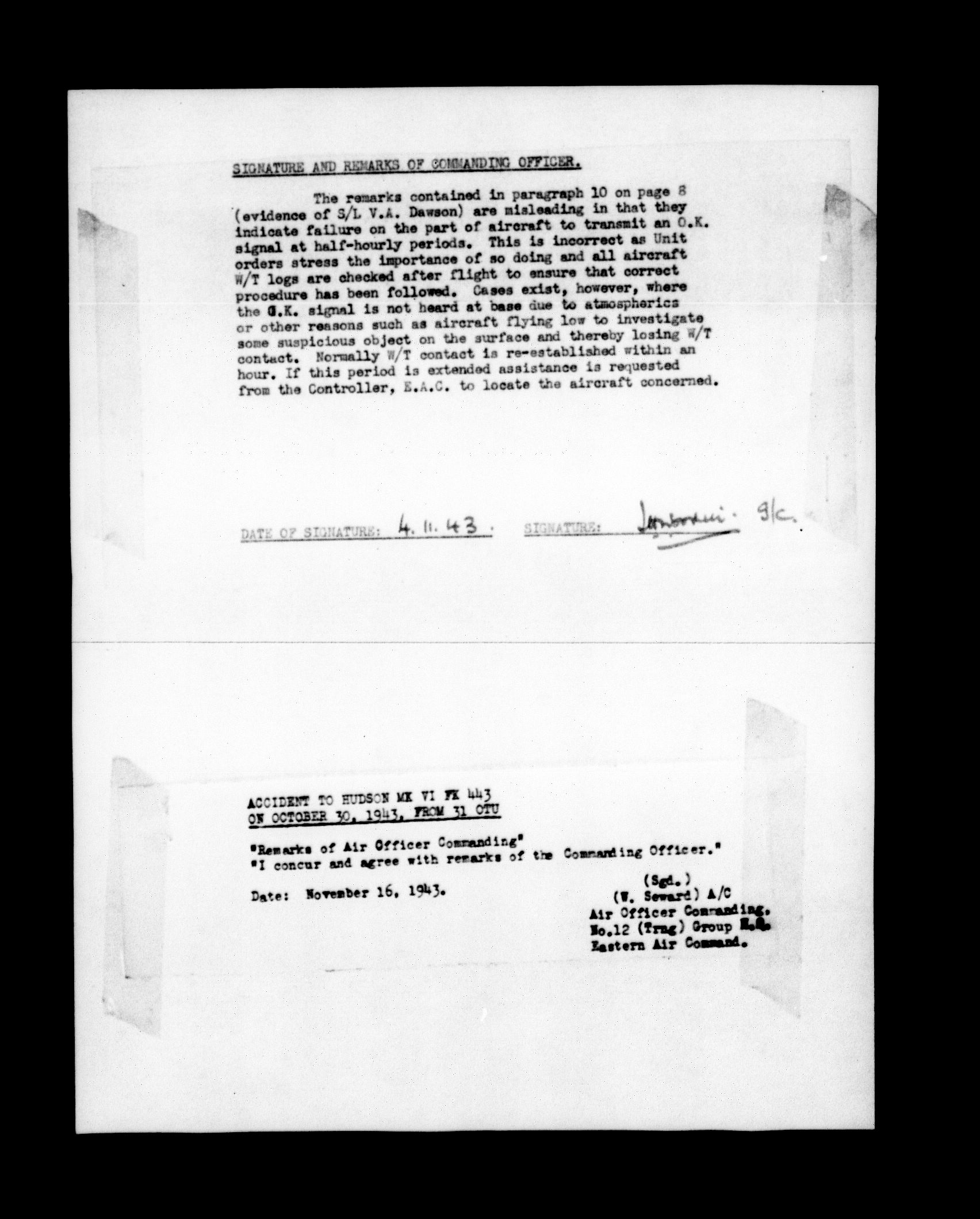
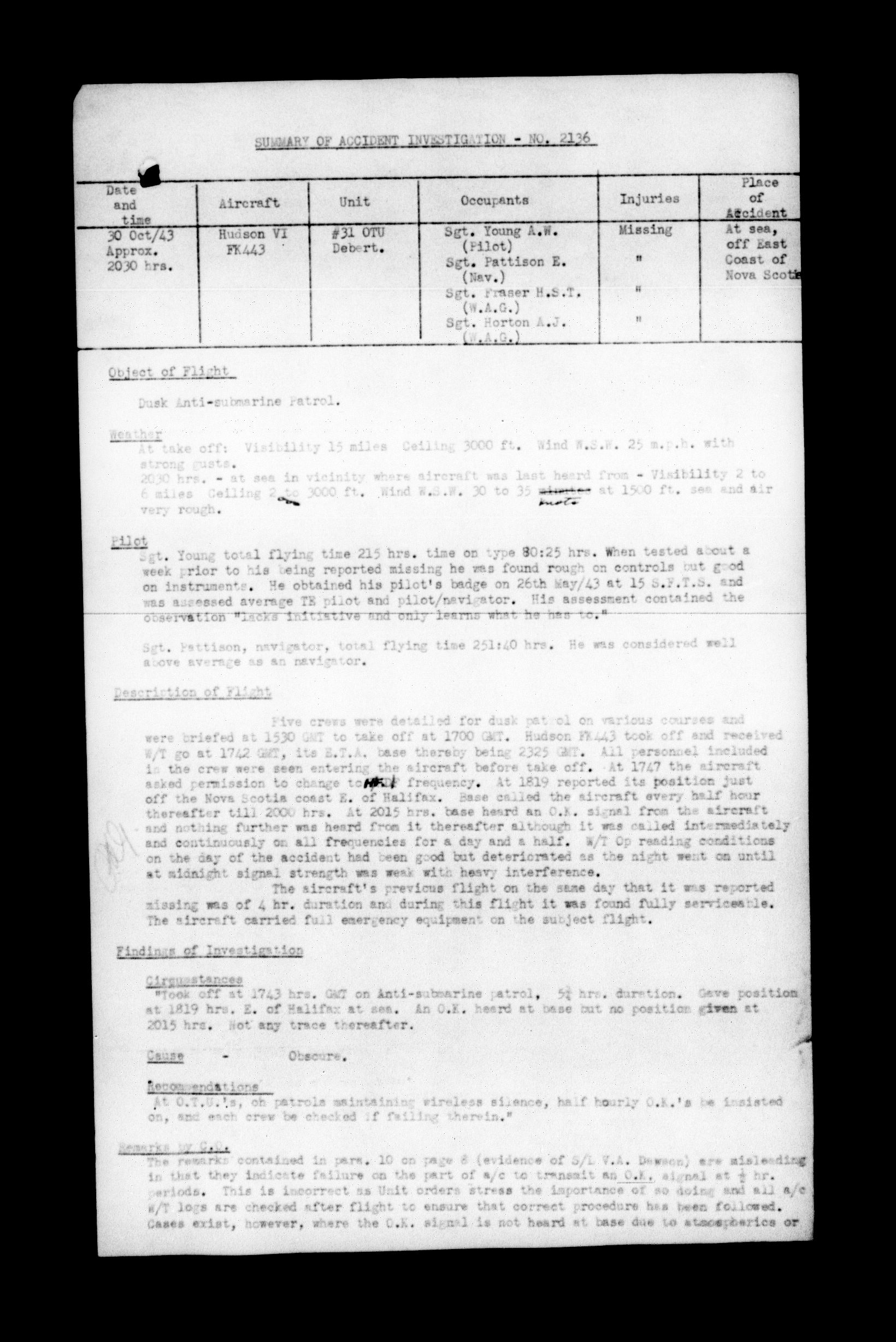
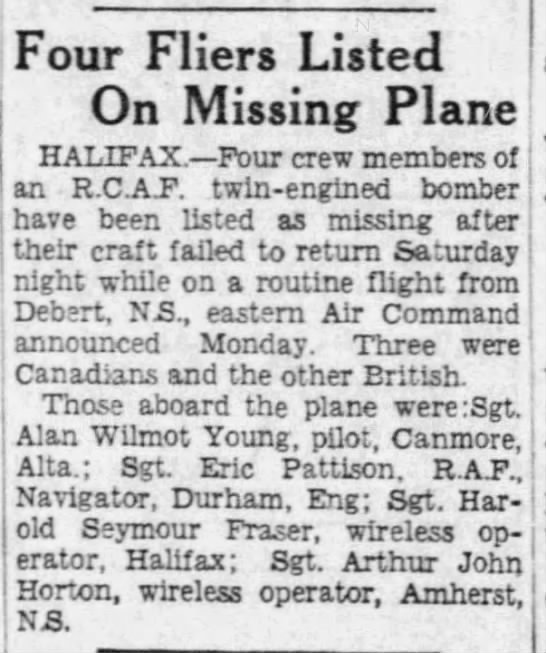
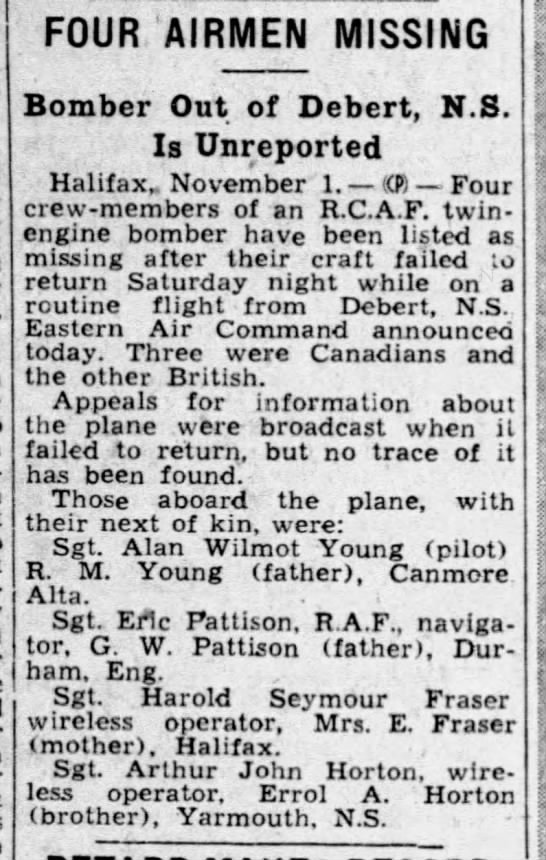
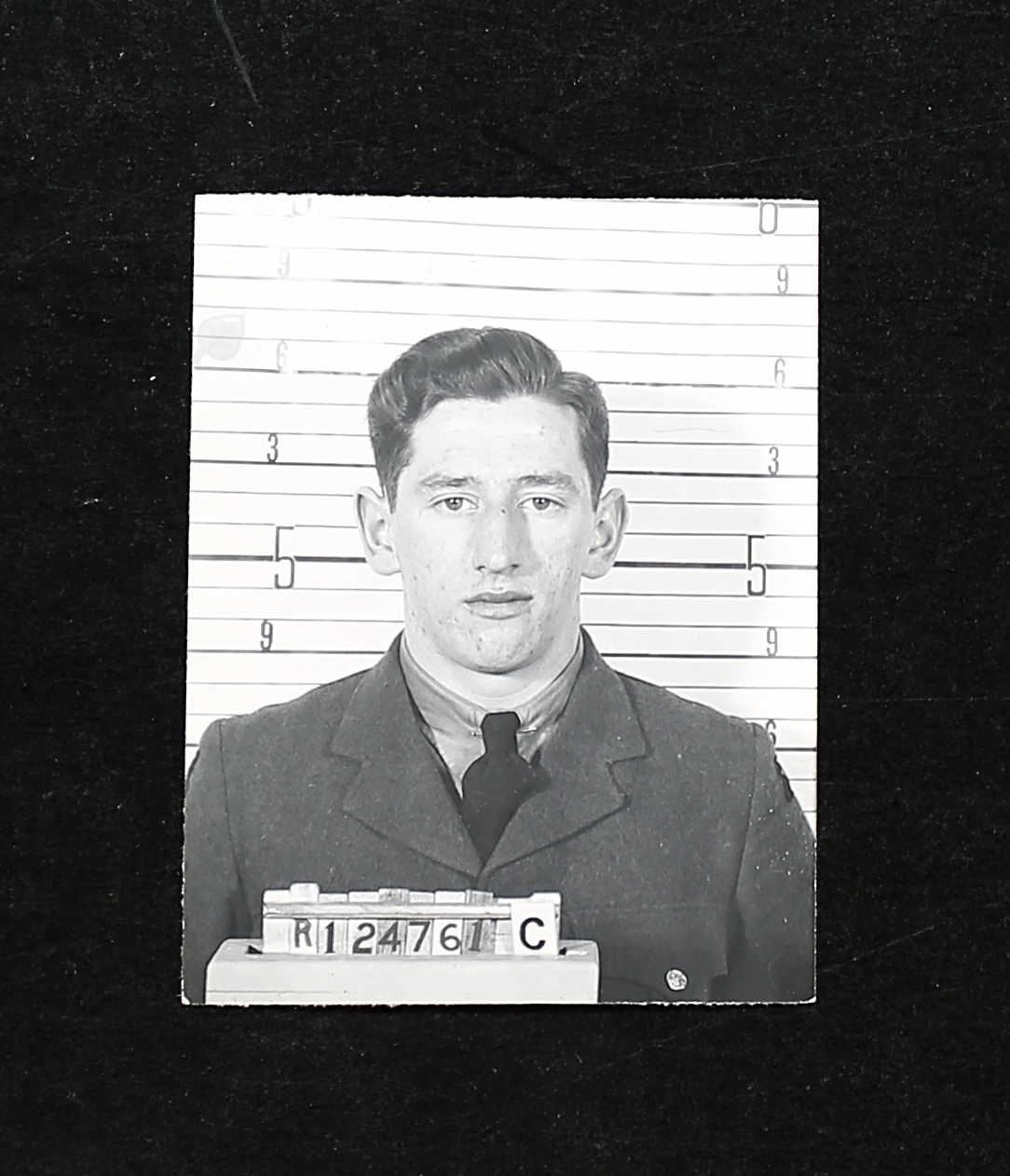


February 20, 1920 - October 30, 1943







Arthur John Horton was the son of Albert Dennis Horton (1870-1940) and Nellie Marion (nee Pugh) Horton (1882-1923). He had three brothers, Earl Kitchener Horton (1917-2008) and Lindsay Dennis Horton (1914-1983) and Everett E. Horton (1922-1983), Canadian Army, overseas, two sisters, Mrs. Alma Frances Bower (1912-2008) and Mrs. Eva Madden (1910-1991). Their sister, Clara, died on March 16, 1936, due to Scarlet Fever. His father died of a stroke at age 69, and his mother died in childbirth. The family attended the United Church.
Arthur was a wholesale clerk with a Grade XI education. Prior to enlisting in the RCAF, he was with No. 60 CA (B) TC, Yarmouth as a private, then with ITC, Aldershot, Kentville, NS, as a private in 1941. He liked to play many sports, including baseball, basketball, volleyball, bowling, table tennis, and hockey. he also liked to swim. He enjoyed fishing and hunting. He could drive a car. “I am very anxious to join the RCAF and become an Air Gunner. Have a special interest in gunnery and knowledge of the Lewis and Bren guns.” August 12, 1941. “Sincere, steady. Good aircrew material.” The RCAF accepted Arthur September 4, 1941 for pilot training.
Arthur stood 5’ 5 ½” tall and weighed 140 pounds. He had hazel eyes and dark brown hair. His teeth: “Fair, two cavities.” He was considered athletic. The distal and a small portion of the middle phalanx of his right third finger were missing.
Arthur, who often signed his name AJ Horton, began his journey through the BCATP at No. 1 Manning Depot, Toronto, September 18, 1941. He was then sent to No. 3 TC HQ, Montreal October 27, 1941. From there, he was sent to No. 3 ITS, Victoriaville, Quebec February 1, 1942 until April 11 of that year. “35th out of 59 in class. 81%. Fair educational background, quiet, unassuming, conscientious, fair aircrew material. Alternate recommendation: observer.”
He was then sent to No. 14 EFTS, Portage la Prairie, Manitoba, April 12, 1942. “A high average student with no particular faults. Very smooth on instruments. Flying very smoothly and has good prospects. 67% final test. Conscientious worker. Average ability. Deportment very good. 15th out of 27. 72%”
Arthur was sent to No. 10 SFTS Dauphin, Manitoba July 4, 1942 for further pilot training. Arthur was in the hospital July 20, 1942. “Unable to grasp instruction. Is erratic and nervous. Progress has been very poor and is unable to solo after ten hours dual. Ground training: During short period on Course, has shown keen interest and ability to absorb ground subjects. Unsuitable service pilot material.” Other comments: “This pupil is absolutely impossible. Is unable to keep even straight and level. Definitely below average. Would never make a service pilot.”
His training was discontinued and Arthur was sent to KTS, Trenton, July 23, 1942. “Not browned off at being C.T.’d. Was impossible at Service. This man likes Morse and chose WAG as his new trade. He is mature, quiet, deliberate, motivated. Not impressive. Average intelligence. A/N or A/B are definitely not his trades.”
He remustered and was sent to No. 4 Wireless School, Guelph, Ontario August 29, 1942 until March 19, 1943. “42nd out of 80 in class. 76.8%.”
Arthur was AWL for five days in October 1942 and forfeited five days’ pay. “14 days confined to barracks. Cost apprehension 64 cents.” He was absent without leave from 0200 hours 12-10-42 to 0045 hours 17-10-42.
He was then sent to No. 6 B&G School, Mountain View, Ontario March 20, 1943 until May 9, 1943. “19th out of 21 in class. This airman’s air firing results were well above average. Hard working, intelligent but need constant supervision.”
From there, he was sent to Eastern Air Command, reporting to No. 31 GRS, then to No. 31 O.T.U. Debert, Nova Scotia August 7, 1943.
On October 30, 1943, the crew aboard Hudson VI FK443 out of Unit 31 O.T.U.: *Sgt. Harold Seymour Thomas Fraser, R76056, WAG, Halifax, NS* Sergeant Arthur John Horton, R124761, WAG, Amherst, NS, *Sergeant Eric Pattison, 1558917 (RAF), navigator, Durham, UK, and *Sergeant Alan Wilmot Young, R159283, pilot, Canmore, AB.
The summary of the court of inquiry can be found on microfiche C-5937, starting at image 3938. Nine witnesses were called.
OBJECT OF FLIGHT: Dusk anti-submarine patrol. WEATHER: At take off, visibility 15 miles. Ceiling 3000 feet, wind WSE 25 mph with strong gusts. 2030 hours: At sea in vicinity where aircraft was last heard from -- visibility 2 - 6 miles; ceiling 2 to 3000 feet. Wind WSW 30-35 knots at 1500 feet, sea and air very rough. [The eighth witness stated that he was on an anti-submarine patrol that same day. “The weather at 2030 hours was very poor, with visibility about four miles, ceiling round about a 1000 feet and with heavy winds. We were flying at 1500 feet altitude. The sea was very rough. Also, the air was very rough.”]
PILOT: Sgt. Young total flying time 215 hours time on type 80.25 hours. When teste about a week prior to his being reported missing, he was found rough on controls but good on instruments. He obtained his pilot’s badge on 26 May 1943 at 15 SFTS and was assessed average TE pilot and pilot/navigator. His assessment contained the observation, “lacks initiative and only learns what he has to.” [The ninth witness, FO Arnett, stated, “Sgt. Young has been on this station about two months and I went up on a test flight with him (A/S Patrol) about a week prior to the missing. I flew the aircraft out. On turning it over to Sgt. Young, I noticed that he was rough on the controls. Coming back, we ran through showers and Sgt. Young flew through these on his instruments very well. On this trip, I explained to hi how to use his tanks, telling him that there was never any need to let a tank run dry.”]
Sgt. Pattison, navigator, total flying time 251.40 hours. He was considered well above average as a navigator. [The seventh witness, WOI Beacham, stated that he had known Pattison for eight weeks and he was “well above average as a navigator. It is very unlikely to get lost on this flight as he was a very reliable navigator.”]
DESCRIPTION OF FLIGHT: Five crews were detailed for dusk patrol on various courses and at 1530 GMT to take off at 1700 GMT. Hudson FK433 took off and received W/T go at 1742 GMT, its ETA base thereby being 2325 GMT. All personnel included in the crew were seen entering the aircraft before take-off. At 1747, the aircraft asked permission to change to ____ frequency. At 1819, reported its position just thereafter till 2000 hours. At 2015 hours, base heard an OK signal from the aircraft and nothing further was heard from it thereafter although it was called intermittently and continuously on all frequencies for a day and a half. W/T Op reading conditions on the day of the accident had been good but deteriorated as the night went on at midnight signal strength was weak with heavy interference. The aircraft’s previous flight on the same day that it went missing was of a four-hour duration and during this flight, it was found fully serviceable. The aircraft carried full emergency equipment on the subject flight.
FINDINGS OF INVESTIGATION: Took off at 1743 hours GMT on anti-submarine patrol. 5 ¾ hours duration. Gave position at 1819 hours east of Halifax at sea. An OK was heard at base but no position given at 2015 hours. Not any trace thereafter.
CAUSE: Obscure. [The usual overdue action was taken at the appropriate time. No trace of any kind was found of this aircraft.]
RECOMMENDATIONS: At O.T.U.’s on patrols maintaining wireless silence, half hourly OKs be insisted on and each crew be checked if failing herein.
When Arthur’s brother, Earl, filled out the Estates form in October 1944, he wrote, “We are sorry to be so long in answering but have been away all summer. We would appreciate it if this matter could be settled immediately because I plan to be leaving Yarmouth again shortly.” Earl was the sole beneficiary to Arthur’s estate.
Arthur kept a diary, listed in his personal belongings.
In late October 1955, Earl, received a letter informing him that since Arthur had no known grave, his name would appear on the Ottawa Memorial.